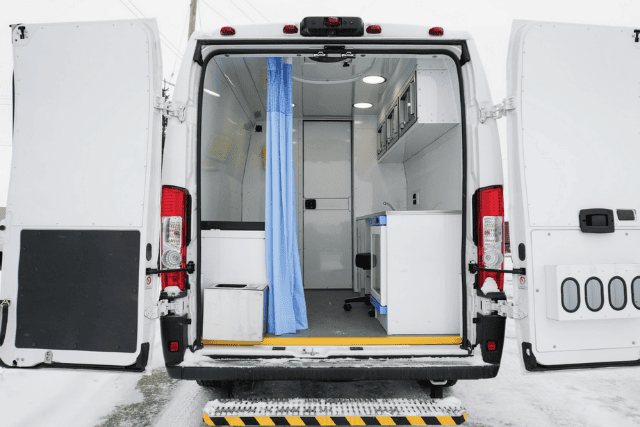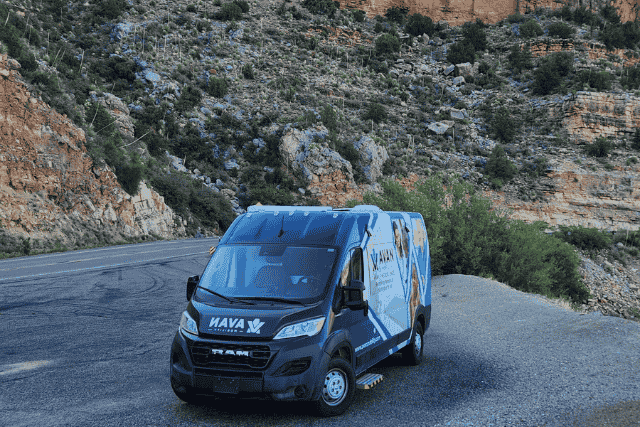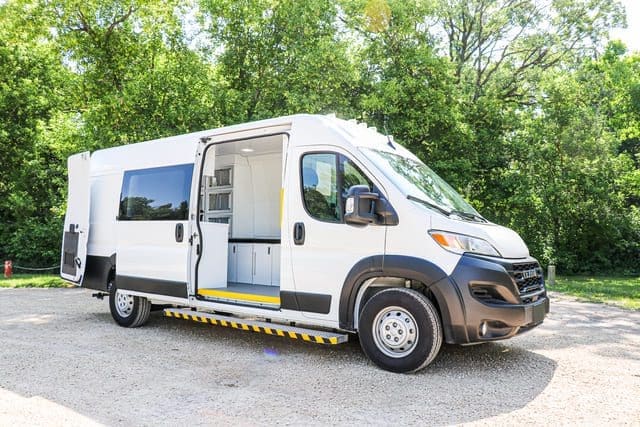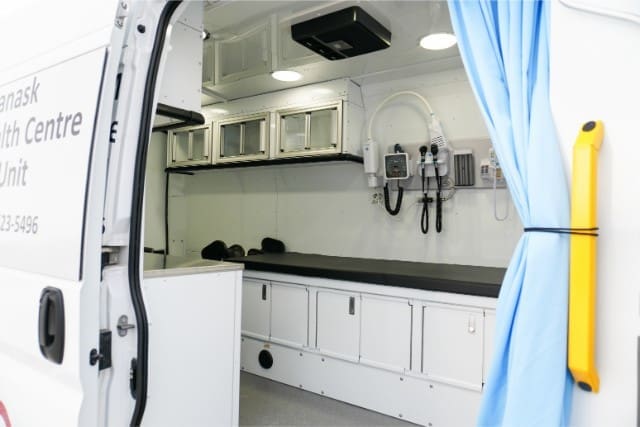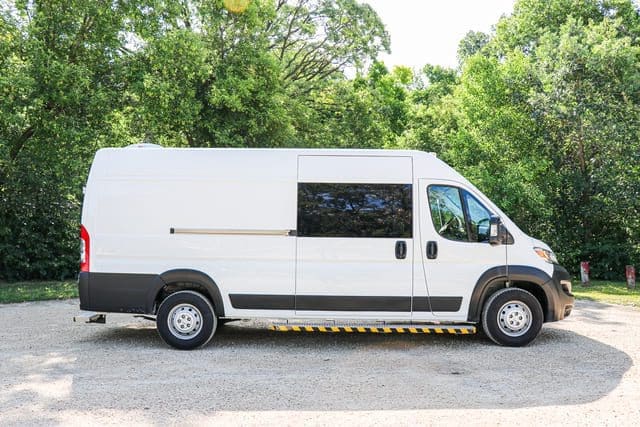Did you know transportation is one of the top reasons people miss healthcare appointments in North Dakota? According to rural health research, many patients in areas like Bottineau County or the Spirit Lake Nation struggle with long travel times, harsh winter roads, or no vehicle access at all.
The result?
- Missed appointments that lead to untreated conditions
- More ER visits
- Burned-out staff trying to keep up
If you run a clinic, Tribal health center, or outreach program, this probably hits home. You’ve tried scheduling around weather, arranging rides, and even rescheduling the reschedules. But the gap stays open. You want to deliver care that’s accessible and consistent, without stretching your team too thin. That’s the gap, and mobile medical units in North Dakota are built to help close it.
At AVAN Mobility, we’ve spent over a decade designing mobile clinics that help communities like yours reach more people. We’re Ford QVM and Stellantis QPro certified, and we’ve helped dozens of programs, such as the one in Joplin, launch their first unit. We build vehicles that support dignity, comfort, and real-world needs because your mission drives everything we do.
In this article, you’ll learn:
- Why healthcare appointments get missed in North Dakota
- How mobile clinics fill the gap
- What to consider when getting started
Why do healthcare appointments get missed in North Dakota?
In North Dakota, missing a doctor’s appointment often has nothing to do with a person’s willingness to show up. It has everything to do with how far they live from care and how hard it is to get there.
1. Long drives and no easy roads
For patients in communities like Beach, Walhalla, or New Town, the closest hospital or specialty clinic could be three to seven hours by car. And that’s on a good day.
The farther someone lives from a healthcare facility, the more likely they are to cancel or miss appointments altogether. When you’re staring down a 14-hour round trip for a 20-minute follow-up, it’s easy to understand why people don’t make the drive.
Key issues with long-distance travel:
- Burnout and stress: Driving hours for routine care wears people down, especially if they’re elderly or unwell.
- Childcare and work conflicts: Missing a full day means lost wages, school pickups missed, and more pressure on already stretched families.
- Fuel and lodging costs: For some, there’s no budget for a hotel stay or the extra tank of gas.
- Poor road conditions: Gravel roads, narrow highways, and aging infrastructure make travel slow and unpredictable.
2. Harsh weather creates risky travel conditions
Let’s talk about the elephant in the room: North Dakota winters are no joke. Between snowstorms, ice-covered roads, and freezing temperatures, it doesn’t take much for travel plans to fall apart.
For someone living in a rural area like Langdon, Watford City, or Ellendale, a routine checkup in January can feel like a survival mission. Even if they want to make the trip, Mother Nature often has other plans.
How North Dakota weather causes missed appointments:
- Blizzards and whiteouts: One storm can shut down highways for hours or even days.
- Black ice and wind chills: These turn even short drives into dangerous ones, especially for seniors or people with health issues.
- Snowed-in vehicles: When the snow piles up, people can’t leave their homes, let alone make it to a clinic two towns over.
- Clinic cancellations: Providers sometimes close or reduce hours during storms, leading to backlogs and delays.
Even spring and fall aren’t always smooth sailing. Flash flooding, slick gravel roads, and sudden temperature drops can make travel unpredictable year-round.
When travel becomes risky, healthcare becomes optional, and missed appointments become the norm.
3. Not everyone has a reliable way to get healthcare
Even if the roads are clear and the hospital’s open, not everyone in North Dakota has a way to get to care. In rural towns like Mott, Cooperstown, or New England, it’s common for households to share a single car or have no vehicle at all.
That appointment slips through the cracks if the car’s unavailable or unreliable.
Common transportation struggles patients face:
- No personal vehicle: Many older adults, low-income families, or young patients don’t drive at all.
- Vehicle breakdowns: Rural driving takes a toll on cars. When a vehicle breaks down, it can stay that way for weeks.
- Limited transit options: Public transportation in much of North Dakota is, frankly, nonexistent.
- Family scheduling conflicts: If the only vehicle is in use by another family member, medical appointments get missed or pushed back.
- Lack of ride programs: Volunteer driver programs or Medicaid transportation aren’t always available when people need them.
All these small problems add up to big gaps in care. And for people with chronic conditions or mental health needs, those missed appointments can lead to bigger health problems over time.
4. Specialty care is often far from home
Primary care might be available in some rural or Tribal communities, but when it comes to specialists, it’s a different story. Most patients have to travel to larger cities like Fargo, Bismarck, Grand Forks, or Minot for things like cardiology, oncology, dialysis, or pediatric care.
And when specialty care is hours away, transportation barriers hit even harder.
Why are appointments to see a specialist missed more often?
- Longer trips required: Even if someone has a ride to their local clinic, they often don’t have support for a trip 200 miles away.
- Frequent visits: Dialysis, prenatal care, and cancer treatments all require multiple trips per week or month. That’s a big ask.
- More time off work: It’s not just the appointment. Travel adds hours, which means lost wages or missed shifts.
- Caretaker strain: Patients needing help often rely on family or neighbors to drive them. People may not always be available.
- Exhaustion and delay: The effort it takes to arrange, coordinate, and travel to care wears people down. So they cancel, or worse, give up.
These missed appointments are about geography, logistics, more than they are about forgetfulness or avoidance.
How do mobile medical units in North Dakota overcome these transportation barriers?
You’ve seen the barriers. People are missing appointments because they live too far from care or have no way to get there. Mobile medical units in North Dakota flip the situation around. Instead of patients coming to you, you meet them where they are, whether that’s a remote community, Tribal land, or a small-town grocery store parking lot.
This kind of care is personal, flexible, and designed for real life in North Dakota.
1. You take healthcare off the highway and into the neighborhood
When you bring care to the community, everything changes. Patients don’t need to worry about driving for hours or finding a ride. They don’t need to miss work or skip an appointment because of snow, gas prices, or car trouble.
Mobile health in North Dakota makes healthcare more reachable by:
- Shortening the distance: You go to the patient’s community, not the other way around.
- Cutting out the stress: No traffic, no icy roads, no packed waiting rooms.
- Making visits more consistent: People keep their appointments when care is nearby.
- Helping you reach more areas: You can schedule visits in towns and rural spots that usually get overlooked.
This is the kind of access that sticks. It’s how programs build trust and keep people healthier long-term. Some teams start with one mobile health unit in North Dakota and quickly realize they need more to keep up with demand.
2. Keeping patients on track with regular, reliable visits
One of the biggest challenges in rural and remote communities is follow-up care. It’s one thing to get someone to a first appointment. It’s another to keep them coming back. That’s where mobile medical clinics in North Dakota shine.
When healthcare is delivered locally on a consistent schedule, patients start to build habits. They expect the mobile team to come. They look forward to their visits. And most importantly, they show up.
Here’s how mobile clinics help create consistency:
- Set, familiar routes: People know when and where the unit will be each week or month.
- Build relationships: Seeing the same providers regularly builds trust and comfort.
- Less skipping, more showing up: Patients aren’t rescheduling or forgetting because the clinic is part of their routine.
- Follow-up without frustration: No extra travel or planning needed, it’s right outside their door.
If you’ve been thinking about a mobile clinic for sale in North Dakota, this kind of patient reliability is one of the biggest long-term wins. Especially in areas where missed appointments used to be the norm.
3. Expanding your reach without opening a new clinic
Setting up a brick-and-mortar clinic in a rural area isn’t easy or affordable. Construction, staffing, equipment, and maintenance can stretch your budget thin. And after all that, you might still only reach a small number of patients. But with a mobile health vehicle, your program becomes flexible, fast-moving, and ready to go where the need is greatest.
Why mobile makes more sense than a permanent building:
- You go where you’re needed: Reach more towns without adding more overhead.
- No zoning headaches or building delays: You’re not stuck waiting months to open your doors.
- Test the waters: Use a mobile unit to try out new routes before committing to a permanent location.
- Adapt with ease: If demand shifts, your team can shift too without starting from scratch.
This is why many care providers are searching for a mobile medical van for sale in North Dakota. It’s a cost-effective way to expand your impact without overextending your team.
A mobile clinic in North Dakota can help you serve more people with less friction, whether you’re delivering mental health services, follow-up appointments, or basic checkups.
4. Building trust by showing up
In many communities across North Dakota, especially among Tribal populations and newcomers, there’s a long history of feeling left behind by the healthcare system. It’s one thing to offer care. It’s another to consistently show up in places like Cannon Ball, Rolla, or Cando, where seeing a provider often feels out of reach.
When your team rolls into town in a mobile health unit in North Dakota, you’re not just offering checkups. You’re offering presence. And that presence builds trust.
Mobile health in North Dakota helps create real connections.
How mobile clinics support stronger relationships:
- Regular presence in underserved towns: In communities like Fort Totten or McClusky, consistent visits help build comfort and routine.
- Support for Tribal Nations: Serving areas within Spirit Lake, Standing Rock, and Turtle Mountain reservations helps bring care closer to home.
- Welcoming care for new Americans: Many recent immigrants settling in Fargo, Grand Forks, and Jamestown may feel more at ease with providers who come to them.
- Dignified, low-barrier access: Especially important for behavioral health, addiction care, and postpartum follow-ups.
Programs using a mobile medical clinic in North Dakota often see no-show rates drop over time, especially in towns where trust was hard to earn. And as more people see that mobile medical clinics in North Dakota are part of the community, they’re more likely to get the care they need.
Ready to reduce missed appointments with a mobile medical unit in North Dakota?
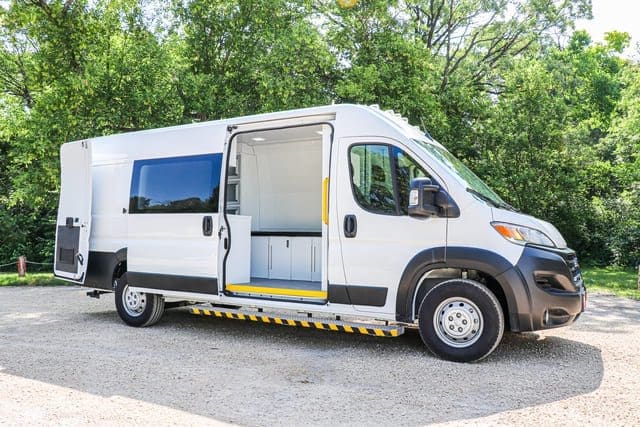
You came here because missed appointments are hurting your patients and your program. Long travel times, unreliable vehicles, and brutal weather have made healthcare harder to reach across rural and Tribal communities in North Dakota.
Now you know:
- What’s causing appointment gaps across the state
- Why transportation is one of the biggest barriers
- How a mobile health vehicle can bring care closer, more often
At AVAN Mobility, we build purpose-driven vehicles that help organizations like yours make healthcare more accessible. Our team has worked with Tribal health leaders, government programs, and rural nonprofits nationwide. We’re not just a manufacturer but your long-term partner in creating a more innovative, stronger healthcare delivery model. If you have questions, we’re here to talk about your vision, not push a sales pitch.
Click the button below to speak with a mobility expert who gets it.
If you’re not ready to talk to a mobility expert yet, we’ve got helpful next steps:
- Top 5 tips on how to start a mobile medical clinic: Get practical advice to move from idea to action faster and smoother.
- Comparing versatility: mobile medical vans or full-size RVs?: This article will help you decide what type of mobile medical vehicle in North Dakota makes the most sense.
